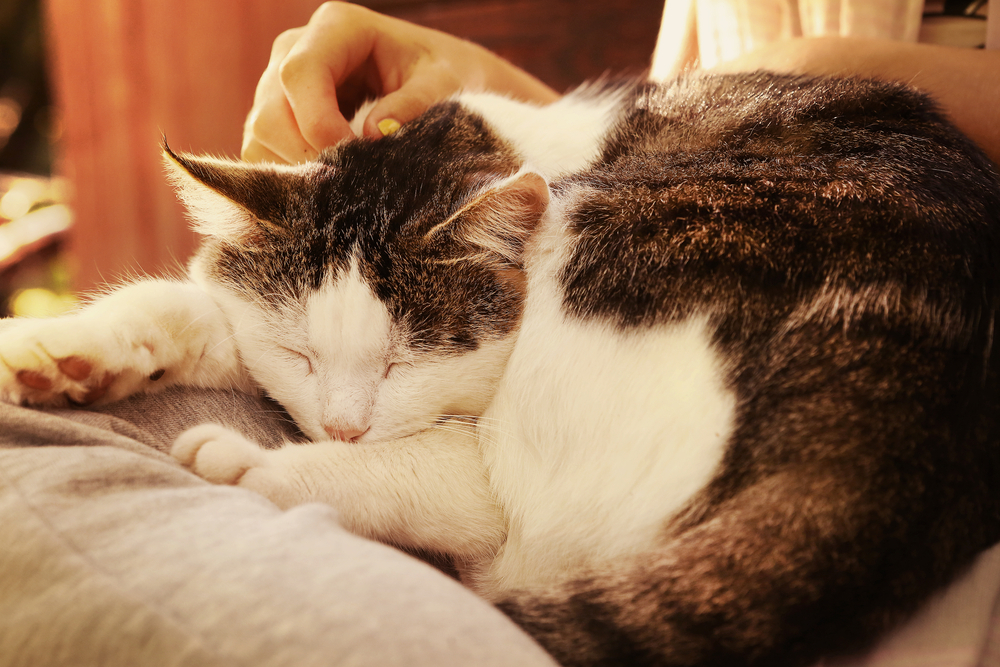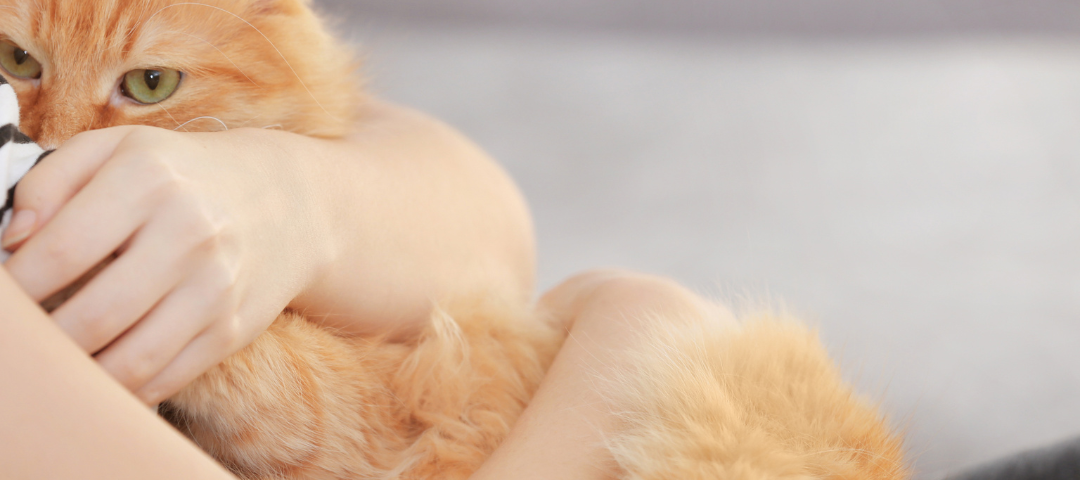
When Is It Time to Say Goodbye to a Cat With Arthritis?
June 23, 2023
Should you put to sleep a dog with vestibular disease?
August 9, 2023End-of-life care is a sensitive subject, and preparing for your cat’s final days can be daunting. But, with the right information and support, you can plan for a gentle goodbye in a comforting setting for you and your cat. Read on to learn more about FIV in cats and how to make that final decision.
Table of Contents:
- What is Feline Immunodeficiency Virus (FIV)?
- How Common is FIV in Cats?
- Causes and Transmission of FIV
- Symptoms of FIV in Cats
- Diagnosing FIV in Cats
- Treatment Options for FIV
- How to Care for a Cat with FIV
- What is The Life Expectancy of a Cat with FIV
- Making the Decision: When to Put a Cat with FIV to Sleep?
- What are the Final Stages of FIV in Cats?
- Gentle Euthanasia for Cats with FIV
What is Feline Immunodeficiency Virus (FIV)?
Feline immunodeficiency virus (FIV) affects the immune system in cats – much like HIV in people, although these conditions cannot pass between humans and cats. The disease is life-long and is commonly transmitted in cat bites.
FIV is a retrovirus that progresses slowly over time. Many cats can live with it and remain healthy for several years. Owners often don’t know their cat has FIV until they become unwell. The virus invades the white blood cells (lymphocytes) that your cat needs to fight disease and, in doing so, suppresses their immune response. This makes FIV cats more prone to infections and other conditions they eventually struggle to recover from.
How Common is FIV in Cats?
The prevalence of FIV is estimated to be around 1-5% in the healthy cat population; however, this depends on location. In areas with a dense population of outdoor cats, disease levels will be higher than in areas where cats are mainly kept indoors. Middle-aged male cats are most commonly infected due to territorial behaviours, but all cats are potentially at risk. In large colonies of cats, populations with a high number of sick cats, and cat shelters, the number of cats with FIV may be far higher.
Causes and Transmission of FIV
Transmission of FIV usually occurs through cat bites and deep scratches. But FIV is carried in saliva, so mutual grooming might be a less common way for the disease to pass between cats. Similarly, the transmission of FIV during mating and from the queen to her kittens in the womb is also possible. Rarely, blood transfusions might be a source of infection; however, all transfusions should be screened for FIV. Luckily, FIV can be easily eliminated from the environment with regular disinfectants.
FIV is most prevalent in un-neutered male cats. Therefore, neutering cats to reduce roaming, fighting, and mating behaviours can substantially reduce FIV levels. Keeping infected cats indoors and separate from other cats will also reduce the spread. Screening for FIV is recommended if you are considering mating your cat or bringing a new cat into the home.
FIV cats living in a multi-cat household can be challenging to separate, particularly if they are close companions. In this case, allocating separate feeding bowls and disinfecting all bowls and litter trays after use is recommended.
Symptoms of FIV in Cats
Because FIV is a disease affecting the immune system, no specific symptoms are common to all cats. Rather, affected cats are more prone to other conditions which they may take longer to recover from. Conventional treatments may be less effective, and illness may become more frequent and severe as FIV progresses.
Non-specific symptoms your FIV cat might experience include:
- Weight loss
- Lethargy
- Fever that comes and goes
- Enlarged lymph nodes
More specific conditions that FIV cats can be prone to include:
- Gastrointestinal diseases (vomiting, diarrhoea, poor appetite)
- Gingivitis or stomatitis (very sore, red gums)
- Respiratory infections (coughing, sneezing, nasal discharge)
- Skin disease and infections (red, ulcerated skin with itchiness, pain and a sticky discharge)
- Conjunctivitis and other eye conditions (gunky discharge from eyes)
- Urinary tract infections (blood in urine, straining to pee)
- Neurological disease (altered behaviour or movement, seizures)
Symptoms are often mild and short-lived during the first few months following infection (acute phase) and then vanish for several years as the virus lays dormant. In the later stages, symptoms will re-emerge and gradually worsen. Your cat will feel more unwell as they become more prone to secondary infections. FIV cats are also more prone to cancers and other immune-related conditions. These illnesses will eventually impact your cat’s quality of life, including eating, human interactions, playing and resting comfortably.
Diagnosing FIV in Cats
Diagnosing FIV is often possible using a simple blood (ELISA) test at your veterinary practice. These tests detect antibodies to the virus. Blood antibodies confirm an FIV infection as the virus remains in the individual lifelong. Unfortunately, no test is 100% accurate. If there is a high suspicion that your cat has FIV, your vet might recommend further tests be requested from a specialist laboratory, e.g., viral PCR or western blot.
Screening for FIV is recommended if your cat is at risk of contracting FIV. In breeding groups, cats should be tested yearly, with the isolation of infected individuals. But any cats that are exposed to FIV should be tested more frequently. Kittens born with FIV antibodies may not be genuinely infected and should be tested every 60 days for at least the first six months of their lives to determine their FIV status.
Treatment Options for FIV
Sadly, there is no cure for FIV, so careful monitoring of your cat is essential to catch any deterioration in their health early. Regular vet checks every six months and annual blood and urine screens are recommended. Weighing your cat every few weeks at home can also be a useful monitoring tool. To avoid infections, your cat should avoid contact with other cats and raw food, which might be a source of bacteria and parasites. Keeping up to date with worm and flea treatments is also recommended.
Treatments for FIV generally relate to secondary conditions. Infections may be treated with antibiotics, and other conditions can be addressed with symptomatic treatments (eye drops, dentistry, anti-sickness medications, pain relief etc.), which can be implemented as needed. There are limited antiviral drugs available to cats. And while these may reduce symptoms in some cases, there is no conclusive evidence that they will extend your cat’s life. Some antiviral medications have serious side effects, so risks and benefits should be considered carefully.
How to Care for a Cat with FIV
All cats are special, but those with FIV need a little extra TLC from their human families. Helping them groom, providing lots of snuggly bedding and quiet spaces for those not-so-good days and enriching your cat’s indoor environment with toys, catnip, cardboard boxes, and scratching posts can improve their well-being. Spending time with your cat, stroking and talking to them, can be incredibly comforting and help ward off loneliness and boredom.
Pheromone and appeasement sprays are available to help your cat feel relaxed. And feeding soft, good quality, and tasty cat food can be helpful if your cat suffers from gum disease. Offering multiple water bowls and litter trays around the home can be beneficial to those cats that are prone to cystitis and urine infections.
What is The Life Expectancy of a Cat with FIV?
There is speculation about the average lifespan of FIV cats, but no one really knows for sure. A healthy cat with FIV can live for many years and, in some cases, potentially as long as their unaffected companions.
One large study at a veterinary referral centre found no difference in overall survival rates of FIV cats compared to non-FIV cats in this group. Another study examining unwell FIV cats found that 63% died within the two-year study period, compared to just 6% of asymptomatic FIV cats. Interestingly, this latter study found that housing conditions (poor hygiene, large groups of cats, increased risk of infections) had the greatest impact on an individual cat’s survival rate.
Making the Decision: When to Put a Cat With FIV to Sleep?
Cats can live with FIV for many years, so it can be hard to know when they are reaching the end, when you should consider euthanasia. The emotional and financial commitment of having a sick pet can be overwhelming, and sometimes, having a frank and open conversation with your vet can help. Ultimately, they want what is best for your cat and can talk you through taking that final step. Online resources such as our cat quality-of-life calculator can also be useful during those precious last weeks and months when emotions run high. After all, you might not notice that your cat is gradually getting worse when you are so wrapped up in caring for them.
What are the Final Stages of FIV in Cats?
When any pet is reaching the end of their life, it can be common to see a decrease in normal behaviours. Your cat might become weaker, eat less, lose weight and generally have less of a sparkle. On top of this, FIV cats pick up more secondary infections, becoming sicker each time. Perhaps vet visits are getting more frequent, or your cat just isn’t making a full recovery from their respiratory infection like they used to. When your cat is so ill that they become dehydrated or have pain and other symptoms that cannot be managed at home, it is essential to ask: “is my cat likely to recover to their previous quality of life?” before you decide to embark on inpatient hospital treatment. If the honest answer is no, then it is probably time to discuss end-of-life care with your vet.
Gentle Euthanasia for Cats with FIV
Euthanasia can be a very gentle experience, and knowing that your cat can pass away quietly and peacefully is reassuring. Planning ahead of time can help this, and speaking to us about the options available as soon as you feel able is a good idea.
Our special veterinary service is devoted to home euthanasia, to make this experience as comfortable and stress-free as possible for you and your beloved cat. In the home setting, you can be involved in how and where you want your pet to pass away, and you can be with them every step of the way if you choose to. Our care coordinators and vets will talk you through the process and what to expect, and you can discuss any worries you have. Knowing that you can help your cat to pass away peacefully and with dignity can be a huge comfort for many families saying goodbye to their special cat.
References:
Bęczkowski, P.M., Litster, A., Lin, T.L., et al. (2015). Contrasting clinical outcomes in two cohorts of cats naturally infected with feline immunodeficiency virus (FIV). Veterinary Microbiology 76(1-2), 50-60>
Liem, B.P., Dhand, N.K., Pepper, A.E., et al. (2013). Clinical findings and survival in cats naturally infected with feline immunodeficiency virus. 27(4), 798-80




